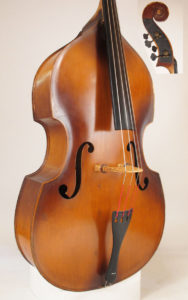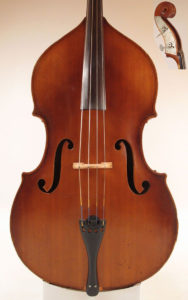Kay-Spotting Basics
Someone who’s new to Kay basses asks, “Can you tell the difference between M1 and C1 basses and why it’s important?”
Kay produced and marketed its basses and cellos using a tiered system to differentiate its products for graduated price points. This began with five tiers before the war and evolved to three in the postwar period. Each tier series contained further variation. The three postwar series, low to high, are Concert, Maestro and Supreme, and from those labels we get the model-designation prefixes C, M and S.
Available from the very beginning of Kay bass and cello production in 1937 through the company’s liquidation in ’69, the C-1 was Kay’s most popular model overall, characterized by its gamba corners, lacquer finish pattern, standard edge pinstriping, black Kluson tuning sets and rosewood fingerboard and appointments. The one below is from 1951.

The M-1 was Kay’s flagship model from the beginning of bass and cello production in 1937 through the company’s liquidation in ’69. Characterized by its violin corners, brass- or nickel-finished Kluson tuning sets and rosewood fingerboard and appointments, it was the secondmost-popular model after the less expensive C-1. The second photo shows one from 1949.

The construction methods are essentially the same for these basses, with key differences in wood grades, finish and appointments. For the player the most important difference is the body shape, specifically the corners, which are used to handle the instrument and can intersect with the player’s body. Cost is the second factor; the M-1 was more expensive to build and cost more to buy when new, and typically attracts a few hundred dollars more on the market.
Images by Upton Bass (uptonbass.com).